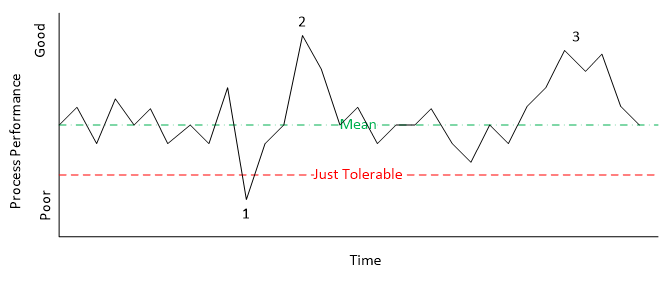A lot of good articles have been written promoting the Six Sigma process improvement methodology.The premise behind Six Sigma is that you can reduce the variability in your processes and get a much more consistent output, thus reducing costs. This is a very laudable objective. However, it does in my opinion contain one major flaw when looking at process improvement.
Six Sigma: Reducing Cost by Reducing Variability
If we take evolution as an example, the concept of survival of the fittest seems to work. Those that change and adapt best to their environment will thrive at the expense of those that do not adapt. Indicating that conforming to a mean may not always be the best strategy, particularly when environments change. Although a rather extreme example, it does provide a good case for variability in the way things are done. The caveat here being within certain boundaries.
The Problem With Six Sigma Process Improvement Methodology:
I watched a programme on television recently describing how tea bags were made and one part covered the blending of various batches of teas to ensure that the tea bags coming out of the process produced a flavour that was consistent day in and day out. From a Quality Control and marketing perspective this made perfect sense. At one point the presenter tasted one of the teas and commented on how good it was. However, the whole process was set up, not to exploit that very good tea, but to produce a consistent flavour that may not be the best. In other words they were sub-optimising the tea to get consistency of flavour.
"The issue I have with Six Sigma, therefore becomes one of reducing variability and therefore finding those cases where expectations are exceeded becomes much less likely."
A long time ago when I was a young quality professional I read an article by Joseph Juran on the concept of Breakthrough and Control. His idea was that by looking at the variations in output from a process, you could identify those outputs that exceeded expectations. A novel idea given that most of us at that time were focussed on preventing outputs that did not meet expectations. Once you had identified those outputs that exceeded expectations, you carry out an investigation into why they were so good and then embed this good practice into the processes. The issue I have with Six Sigma, therefore becomes one of reducing variability and therefore finding those cases where expectations are exceeded become much less likely. In other words, we become like the tea bag operation where for commercial reasons we go for a consistent product day in day out. Great in some organisations like the tea bag manufacturer but not ideal in all situations.
The diagram below provides a view of the performance of a process over time...

Typically we would react at point 1 where the process is behaving poorly and take some form of corrective action. My experience has been that action is unlikely to be taken at points 2 and 3. We would just accept the result and stop short of finding out why the process is performing so well.
Encouraging Out of the Box Thinking = Variability
Processes are either carried out by machines or by humans. Whilst machines thrive in an environment where there is consistency and a lack of variability, humans do not and in my experience will always try to find ‘better’ ways (or more varied ways) of doing things either to reduce boredom or out of curiosity. Therefore, encouraging people to be creative in what they do (within limits) increases both the quality of their working life as well as the variability of the output, which if harnessed properly can lead to an improved product. The drawback being that if the right controls are not in place the process goes out of control. Somewhere between tight control and virtual anarchy lies the optimum.
For more on this idea, take a look at one of our recent blog posts written by Triaster's Managing Director, Michael Cousins: The 3 Bears Approach to Process Management: Too Hot, Too Cold & Just Right which explores the idea that too much and too little process is a bad thing which is why it's important to find the right balance.
My view is that methodologies such as Six Sigma that aim to make processes more consistent in their output, are important and provide benefit, but too much is not always the best way forward. A bit of variability where we can learn from the peaks can help us drive to even better processes rather than accepting a consistent mean caused by crunching down on the standard deviation; Unless of course your processes are machine driven where consistency makes for greater efficiency or like the tea bag manufacturers where consistency of product is a market driver. Add to this the general rule the tighter the controls you have to maintain consistency the greater the costs of those controls, there is a good case for allowing sufficient variability to help drive improvements without sacrificing costs.
I started with a point about evolution, I'll leave you with a question:
'Where would we be if nature had adopted a strategy for consistency rather than variability?
Looking for More Business Improvement Articles?
If you liked that article, why not check out more of our blog articles starting with How to Get the Best Return on Investment From 6 Common Business Goals... 
Related Articles:
The 3 Bears Approach to Process Management: Too Hot, Too Cold & Just Right
How to Get ISO 9001 Certification: From An Expert- Part 1
What are the 7 Wastes That are Killing Business Efficiency?
How to Avoid the Human Error Problem in Process Improvement Techniques
Written by Terry Giles
Terry Giles is a consultant for TerryAG Consultancy. He has a great deal of experience in developing Business Management Systems based around a variety of models including ISO 9001, TL 9000, ISO 14001, EFQM, Baldrige, CMMi, ITIL, RiskIT and CobiT 4.1 & 5.

